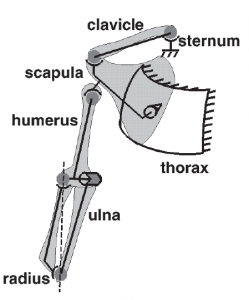I began the arm design by researching how the human arm works, as well as various equivalent joint models which have been developed. My plan was to replicate human physiology to the greatest extent possible.
While much of the motion of the human forearm is relatively straightforward, the pronation and suppination (i.e. “twisting” inward and outward, respectively) of the forearm is surprisingly complex. Maurel et al presented a mechanical model of the forearm joints in a 1996 paper entitled “A Biomechanical Musculoskeletal Model of Human Upper Limb for Dynamic Simulation”. In it, they modeled the forearm joints as a combination of cylindrical and spherical joints, as shown here:
 However, note that the surface to which the wrist is attached changes its orientation as the forearm is rotated, as shown here:
However, note that the surface to which the wrist is attached changes its orientation as the forearm is rotated, as shown here:
This means that without correction, the wrist in our arm would rotate to the left or right as the forearm was twisted.
Another challenging aspect of the forearm motion is the musculature involved. Somewhat counter-intuitively, the two directions of twisting are driven by different, non-symmetric muscles. As shown in this video, the muscles which pronate the forearm (pronator teres and pronator quadratus) are both contained in the forearm. However, the muscles which suppinate the forearm (biceps brachii and suppinator muscle) are located in the upper arm and forearm respectively.